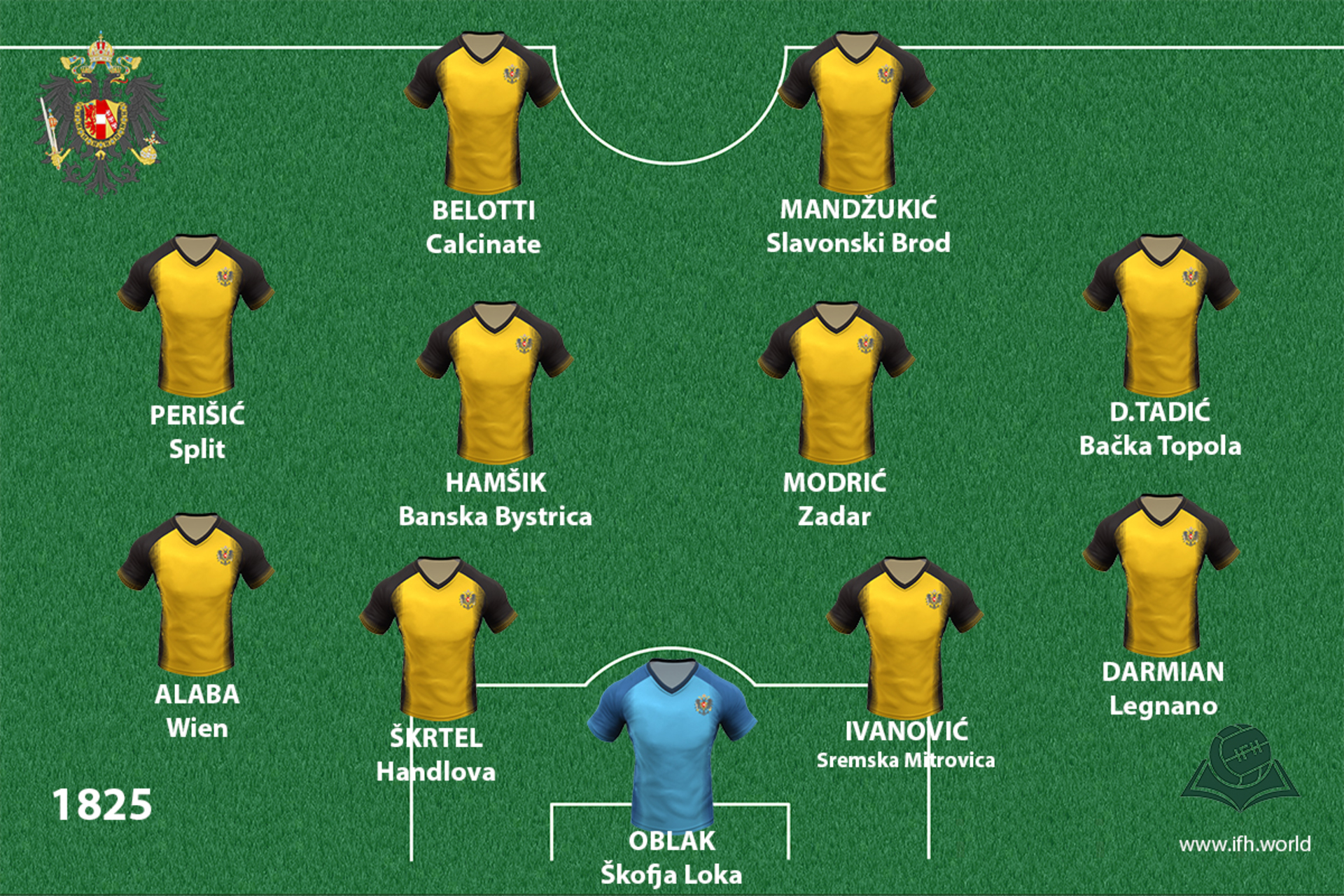Austrian Empire
Austrian Empire was one of the major proponents and guardians of the ancient regimein the Post-Napoleonic Europe , apropos opponent of ideas of the French Revolution.

Coat of arms

Shirt
| Position | First name | Last name | Mjesto rođenja | Like | Dislike | |
|---|---|---|---|---|---|---|
| GK | Jan | OBLAK | Škofja Loka |
45 |
7 |
|
| GK | Petr | CECH | Plzeň |
10 |
0 |
|
| DC | Aleksandar | DRAGOVIĆ | Vienna |
7 |
4 |
|
| DC | Martin | ŠKRTEL | Handlová |
32 |
10 |
|
| DC | Milan | ŠKRINIAR | Žiar nad Hronom |
41 |
6 |
|
| DRC | Branislav | IVANOVIĆ | Sremska Mitrovica |
43 |
15 |
|
| DRL | Matteo | DARMIAN | Legnano |
3 |
2 |
|
| DRL | Šime | VRSALJKO | Rijeka |
54 |
7 |
|
| DR | Andrea | CONTI | Lecco |
3 |
0 |
|
| DR | Lukasz | PISZCZEK | Goczałkowice-Zdrój |
14 |
3 |
|
| DR/MR | Darijo | SRNA | Metković |
13 |
10 |
|
| DL/MLC | David | ALABA | Vienna |
28 |
3 |
|
| DMC | Manuel | LOCATELLI | Lecco |
1 |
1 |
|
| DMC | Milan | BADELJ | Zagreb |
45 |
6 |
|
| MC | Luka | MODRIĆ | Zadar |
90 |
8 |
|
| MC | Mateo | KOVAČIĆ | Linz |
20 |
0 |
|
| MC | Roberto | GAGLIARDINI | Bergamo |
3 |
2 |
|
| MRLC | Marcelo | BROZOVIĆ | Zagreb |
45 |
5 |
|
| AMC/SS | Marek | HAMŠIK | Banská Bystrica |
39 |
5 |
|
| AMRLC | Dušan | TADIĆ | Bačka Topola |
21 |
9 |
|
| AMRL | Ivan | PERIŠIĆ | Split |
80 |
5 |
|
| AMRL | Mijat | GAĆINOVIĆ | Novi Sad |
9 |
10 |
|
| FRLC | Ante | REBIĆ | Split |
41 |
1 |
|
| FRLC | Manolo | GABBIADINI | Calcinate |
4 |
1 |
|
| FRLC | Mario | MANDŽUKIĆ | Slavonski Brod |
50 |
1 |
|
| FRLC | Marko | ARNAUTOVIĆ | Wien |
8 |
3 |
|
| FRLC | Marko | PJACA | Zagreb |
18 |
0 |
|
| FC | Andrea | PETAGNA | Trieste |
1 |
4 |
|
| FC | Andrea | BELOTTI | Calcinate |
5 |
3 |
|
| FC | Patrik | SCHICK | Prague |
6 |
4 |
|
| FC/SS | Andrej | KRAMARIĆ | Zagreb |
44 |
3 |
After the Napoleonic Wars and the Congress of Vienna (1815), the Habsburg Hereditary Lands and, of course, the Habsburg rulers were in two political creations – the German Confederation and the Austrian Empire. The latter also saw its territory expanded in Napoleon’s Italy and the Venetian Republic, making the empire a Mediterranean power and a part of western Europe. The question of Italy would remain a central part of Austrian foreign politics for the next forty years. While the German Confederation struggled for power with Prussia, the Habsburgs of the Austrian Empire had to stand up to the strengthening of national movements, notably those of the Czechs and Hungarians.
Due to German dominance in political life, as well as the domination of German language in social and cultural life, the pan-Slavic (Greek pan – all) arose at the initiative of Czech and Slovak intellectuals. It manifested as cooperation of Slavic peoples in the empire (Czechs, Slovaks, Croats, Poles, Rusyns, Slovenians, Serbs) in matters of culture (language, literature). Inspired by the ideas of the French Revolution about a nation, Slavic intellectuals realized that they could achieve their social and national recognition only through cooperation and strengthening of mutual connections. They did not demand any independent national country and, in fact, expressed their loyalty to the Habsburg emperor
The period of restoration, in which chancellor Klemens Metternich (1809-48) tried to establish domestic and foreign relations based on preserving existing values, would last until the revolutionary events in 1848 and 1849, which were a significant blow to Habsburg authority. Therefore, even though it would come out of them as a victor, it still had to adapt to certain modernization reforms.
Sources
- Miran MARELJA, ''Međunarodni odnosi Prusije od Bečkog kongresa do ujedinjenja Njemačke (1815. - 1871.)'', Pravnik, 45/2012., br.91
- Nikša STANČIĆ, ''Ideja o "slavenskoj uzajamnosti" Jana Kollara i njezina hrvatska recepcija'', Radovi Zavoda za hrvatsku povijest, 30/1997, br.1,
- Alan John Percivale TAYLOR, Habsburška monarhija: 1809-1918., Zagreb, 1990.
- Coat of Arms, https://en.wikipedia.org/wiki/Coat_of_arms_of_Austria-Hungary
